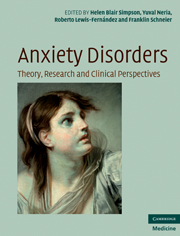Crossref Citations
This Book has been
cited by the following publications. This list is generated based on data provided by Crossref.
Starcevic, Vladan
2013.
Separation anxiety disorder in adults: Is the neglect real?.
Australian & New Zealand Journal of Psychiatry,
Vol. 47,
Issue. 2,
p.
188.
Curta, Catalin
Crisan, Septimiu
and
Ciupa, Radu V.
2013.
Prefrontal Cortex Magnetic Stimulation, a Simulation Analysis.
Advanced Engineering Forum,
Vol. 8-9,
Issue. ,
p.
631.
Alonim, Hanna A.
2014.
Further Thoughts on Miriam Voran’s Response: Containment, Origin of the Self, and Pathways to Autism.
Journal of Infant, Child, and Adolescent Psychotherapy,
Vol. 13,
Issue. 3,
p.
270.
Ushijima, Kayo
Sung, Woncheol
and
Matsutani, Mitsuru
2014.
Psychosocial factors associated with chronic distress in mothers of young children 2 years after the Fukushima nuclear accident
.
Stress Science Research,
Vol. 29,
Issue. 0,
p.
84.
Remes, Olivia
Brayne, Carol
van der Linde, Rianne
and
Lafortune, Louise
2016.
A systematic review of reviews on the prevalence of anxiety disorders in adult populations.
Brain and Behavior,
Vol. 6,
Issue. 7,
Bezanson, David
2016.
Zen and Happiness: Scientific Research on their Relationship.
SSRN Electronic Journal ,
Al-Khotani, Amal
Bello, Lanre A'aziz
and
Christidis, Nikolaos
2016.
Effects of audiovisual distraction on children’s behaviour during dental treatment: a randomized controlled clinical trial.
Acta Odontologica Scandinavica,
Vol. 74,
Issue. 6,
p.
494.
Gallegos, Francisco
2017.
Moods Are Not Colored Lenses: Perceptualism and the Phenomenology of Moods.
Philosophia,
Vol. 45,
Issue. 4,
p.
1497.
Costa, Francine S.
Cademartori, Mariana G.
Silva, Manuela F.
Nascimento, Gustavo G.
Shqair, Ayah Q.
Pinheiro, Ricardo T.
Demarco, Flávio F.
and
Goettems, Marília L.
2018.
Anxiety symptoms have a direct effect on oral health perception in young women.
Quality of Life Research,
Vol. 27,
Issue. 6,
p.
1583.
Scott, I. C.
Machin, A.
Mallen, C. D.
and
Hider, S. L.
2018.
The extra-articular impacts of rheumatoid arthritis: moving towards holistic care.
BMC Rheumatology,
Vol. 2,
Issue. 1,
Brudkowska, Żaneta
Tomczyk, Małgorzata
Jusiak, Katarzyna
Karakuła-Juchnowicz, Hanna
and
Rudnicka-Drożak, Ewa
2018.
The role of beta-adrenolytic drugs in treating anxiety disorders.
Current Problems of Psychiatry,
Vol. 19,
Issue. 3,
p.
209.
Basler, Jaromír
and
Mrázek, Michal
2018.
Počítačové hry a jejich místo v životě člověka.
Remes, Olivia
Wainwright, Nicholas W J
Surtees, Paul
Lafortune, Louise
Khaw, Kay-Tee
and
Brayne, Carol
2018.
A strong sense of coherence associated with reduced risk of anxiety disorder among women in disadvantaged circumstances: British population study.
BMJ Open,
Vol. 8,
Issue. 4,
p.
e018501.
Kandola, Aaron
Vancampfort, Davy
Herring, Matthew
Rebar, Amanda
Hallgren, Mats
Firth, Joseph
and
Stubbs, Brendon
2018.
Moving to Beat Anxiety: Epidemiology and Therapeutic Issues with Physical Activity for Anxiety.
Current Psychiatry Reports,
Vol. 20,
Issue. 8,
Chaturvedi, Santosh K
Manche Gowda, Shayanth
Ahmed, Helal Uddin
Alosaimi, Fahad D
Andreone, Nicola
Bobrov, Alexey
Bulgari, Viola
Carrà, Giuseppe
Castelnuovo, Gianluca
Girolamo, Giovanni de
Gondek, Tomasz
Jovanovic, Nikola
Kamala, Thummala
Kiejna, Andrzej
Lalic, Nebojsa
Lecic-Tosevski, Dusica
Minhas, Fareed
Mutiso, Victoria
Ndetei, David
Rabbani, Golam
Somruk, Suntibenchakul
Srikanta, Sathyanarayana
Taj, Rizwan
Valentini, Umberto
Vukovic, Olivera
Wölwer, Wolfgang
Cimino, Larry
Nouwen, Arie
Lloyd, Cathy
and
Sartorius, Norman
2019.
More anxious than depressed: prevalence and correlates in a 15-nation study of anxiety disorders in people with type 2 diabetes mellitus.
General Psychiatry,
Vol. 32,
Issue. 4,
p.
e100076.
Montero-Marin, Jesus
Garcia-Campayo, Javier
Pérez-Yus, Mari Cruz
Zabaleta-del-Olmo, Edurne
and
Cuijpers, Pim
2019.
Meditation techniques v. relaxation therapies when treating anxiety: a meta-analytic review.
Psychological Medicine,
Vol. 49,
Issue. 13,
p.
2118.
Remes, Olivia
Lafortune, Louise
Wainwright, Nick
Surtees, Paul
Khaw, Kay-Tee
and
Brayne, Carol
2019.
Association between area deprivation and major depressive disorder in British men and women: a cohort study.
BMJ Open,
Vol. 9,
Issue. 11,
p.
e027530.
Rokvić, Nikola
2019.
The validation of the Serbian version of the general anxiety disorder scale (GAD7): A pilot study.
Engrami,
Vol. 41,
Issue. 2,
p.
68.
Carnes, Amy
Matthewson, Mandy
and
Boer, Olivia
2019.
The contribution of parents in childhood anxiety treatment: A meta‐analytic review.
Clinical Psychologist,
Vol. 23,
Issue. 3,
p.
183.
Kiani, Zahra
Simbar, Masoumeh
Hajian, Sepideh
Zayeri, Farid
Shahidi, Maryam
Saei Ghare Naz, Marzieh
and
Ghasemi, Vida
2020.
The prevalence of anxiety symptoms in infertile women: a systematic review and meta-analysis.
Fertility Research and Practice,
Vol. 6,
Issue. 1,



